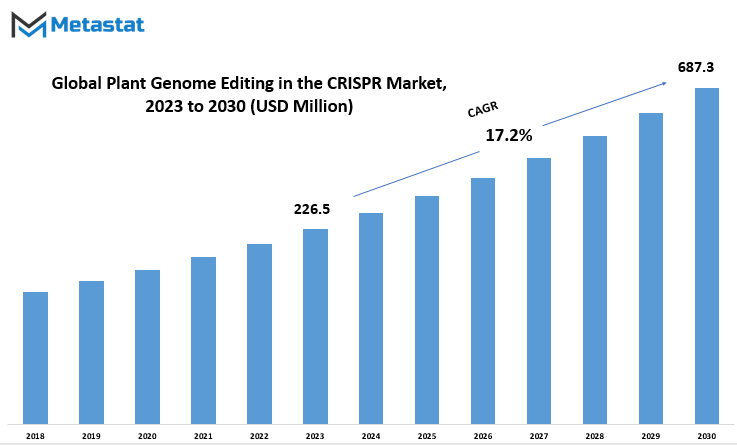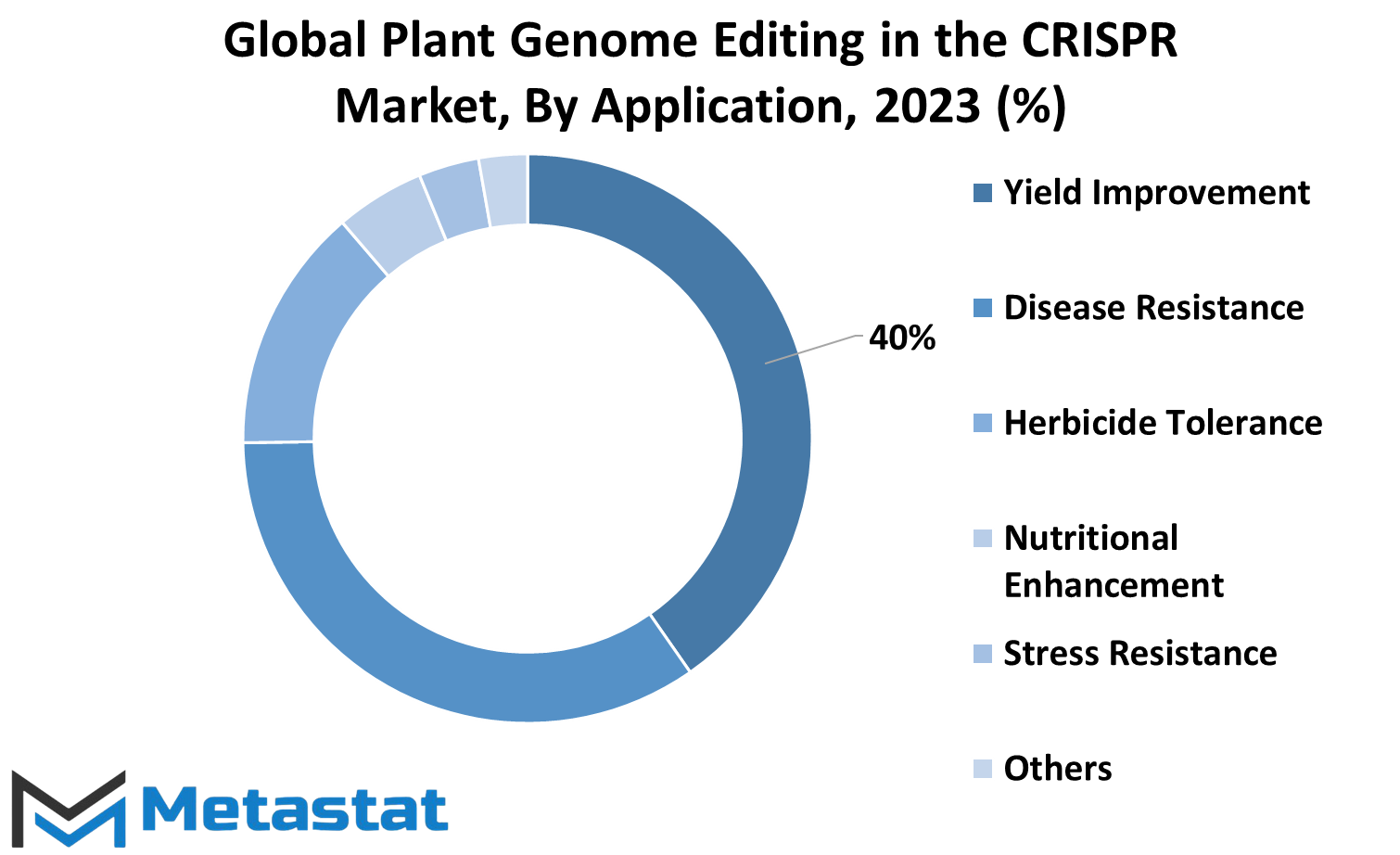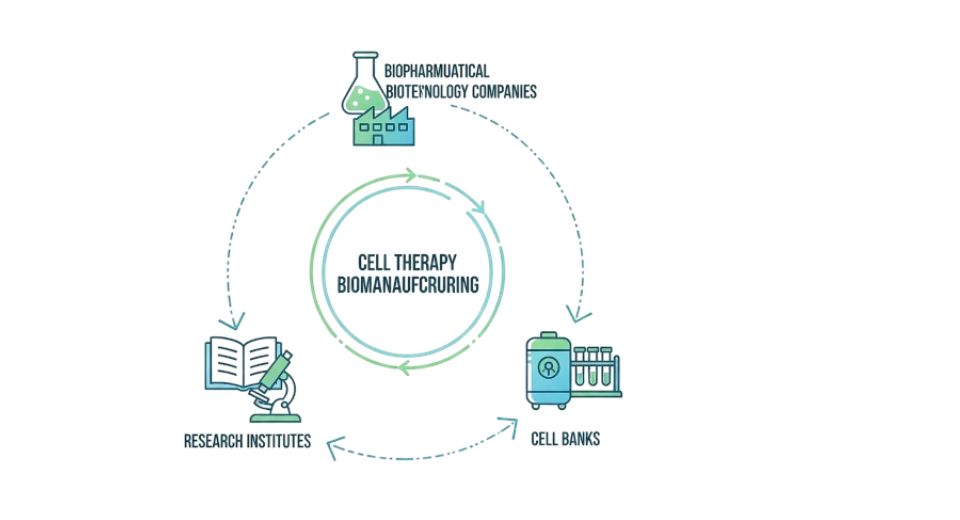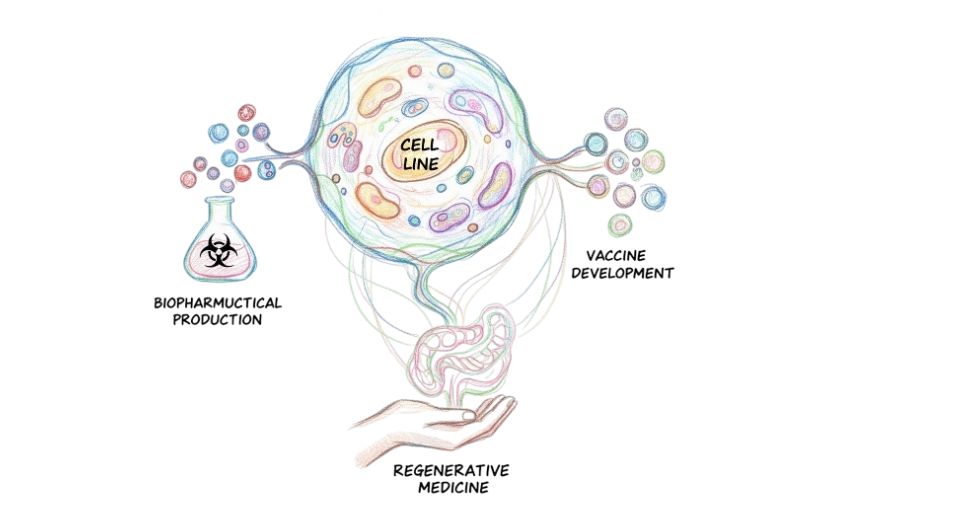MARKET OVERVIEW
The Global Plant Genome Editing in the CRISPR market stands as a testament to the cutting-edge advancements in genetic engineering, revolutionizing the landscape of agriculture and crop improvement. Plant genome editing through CRISPR has emerged as a powerful tool, enabling scientists and researchers to precisely modify the DNA of plants, thereby enhancing desirable traits and mitigating vulnerabilities. This technology has transcended traditional breeding methods, offering unprecedented precision and efficiency in the quest for developing crops with improved yields, resilience, and nutritional content.
One of the key applications of CRISPR in the plant genome editing domain is its role in addressing global agricultural challenges. As the world grapples with the increasing demand for food production amidst environmental uncertainties, CRISPR technology provides a targeted approach to fortify crops against pests, diseases, and adverse climatic conditions. This not only ensures food security but also contributes to sustainable agricultural practices.
Moreover, the CRISPR market's impact extends beyond traditional crop improvement. It plays a pivotal role in the development of bioengineered crops with enhanced nutritional profiles, contributing to the fight against malnutrition and dietary deficiencies. The precision offered by CRISPR technology allows for the modification of specific genes responsible for nutrient synthesis, opening new avenues for creating biofortified crops that address global health challenges.
The global scope of the Plant Genome Editing in the CRISPR market is reflected in its application across diverse plant species. From staple crops like rice, wheat, and corn to specialty crops and horticultural plants, CRISPR technology presents a versatile tool for tailor-made genetic modifications. This adaptability not only caters to the varied needs of different crops but also fosters innovation in sectors such as pharmaceuticals and bioenergy, where plant-derived products are integral.
As the CRISPR market continues to evolve, collaborations between biotechnology firms, research institutions, and agricultural entities are becoming increasingly prevalent. These partnerships facilitate the seamless integration of CRISPR technology into practical agricultural scenarios, bridging the gap between laboratory discoveries and on-field applications.
The Global Plant Genome Editing in the CRISPR market epitomizes the strides made in genetic engineering to address the pressing challenges facing global agriculture. It is not merely a technological trend but a transformative force that holds the promise of shaping the future of food production, sustainability, and human well-being. The precision, efficiency, and versatility offered by CRISPR technology position it as a beacon in the realm of plant genome editing, heralding a new era in agricultural innovation.
Global Plant Genome Editing in the CRISPR market is estimated to reach $687.3 Million by 2030; growing at a CAGR of 17.2% from 2023 to 2030.

GROWTH FACTORS
In the Global Plant Genome Editing in the CRISPR market, several factors play pivotal roles in steering its trajectory. The growth factors stand tall as the driving forces, propelling the market forward. These factors, instrumental in shaping the market's positive trajectory, are crucial to its ongoing development.
Conversely, challenges also loom on the horizon. Factors such as [specific challenges] pose potential hurdles, potentially impeding the seamless growth of the market. It's essential to acknowledge these obstacles, as they influence the market dynamics, prompting a need for strategic considerations.
There exists a silver lining — lucrative opportunities. These opportunities emerge as beacons of potential, promising a favorable landscape for the market in the coming years. While challenges test resilience, opportunities provide avenues for growth and innovation.
The Global Plant Genome Editing in the CRISPR market is a dynamic interplay of growth factors, challenges, and opportunities. The market's trajectory is not a linear path, but a multifaceted journey influenced by a delicate balance of these elements. As the market navigates through these dynamics, it adapts and evolves, shaping the future of plant genome editing in the CRISPR market.
MARKET SEGMENTATION
By Application
The Global Plant Genome Editing in the CRISPR market presents a nuanced segmentation by application, showcasing the diverse ways this technology is harnessed in agriculture. The applications are varied, addressing distinct aspects crucial for enhancing crop quality and yield.
One significant segment is Yield Improvement, a focal point for agricultural advancement. Through CRISPR, scientists aim to optimize crop yields, ensuring a more efficient use of resources and meeting the demands of a growing population. This application is at the forefront of efforts to enhance global food production sustainably.
Disease Resistance stands as another pivotal application. In the unpredictable world of agriculture, crops are vulnerable to various diseases that can significantly impact yield. CRISPR technology is leveraged to bolster plants' natural defenses, creating disease-resistant varieties that contribute to more resilient and reliable agricultural systems.
Herbicide Tolerance is a practical application in modern agriculture. By modifying plant genomes, researchers develop crops that can withstand specific herbicides, providing farmers with effective weed management tools. This not only simplifies cultivation practices but also contributes to more sustainable farming methods.
Nutritional Enhancement is a segment focused on addressing the nutritional needs of a growing population. Through CRISPR, scientists try to enhance crops' nutritional content, ensuring that they yield more and improve dietary health. This application aligns with the global goal of combating malnutrition and enhancing food quality.
Stress Resistance is a versatile application encompassing various environmental stresses. Climate change poses challenges to crop production, and CRISPR technology plays a role in developing plants that can withstand adverse conditions such as drought, extreme temperatures, and soil salinity. This contributes to the resilience of agriculture in the face of a changing climate.
The broad category of Others encapsulates additional applications that may emerge as the field of plant genome editing advances. It signifies the dynamic nature of CRISPR technology, with ongoing research uncovering new possibilities and applications. This category represents the innovative spirit that propels agricultural science forward.
The segmentation of the Global Plant Genome Editing in the CRISPR market by application reflects the practical and impactful ways in which this technology is applied in agriculture. From bolstering disease resistance to enhancing nutritional content and addressing environmental stresses, CRISPR's applications underscore its role in shaping the future of sustainable and resilient agriculture.

By Plant Type
In the Global Plant Genome Editing in the CRISPR market, the division by plant type sheds light on the varied applications of this revolutionary technology. It delineates three primary categories: Crops, Horticulture, and Trees and Forest Plants.
Crops, commanding a value of 116.3 USD Million in 2022, form a significant portion of the market. This segment underscores the pivotal role of genome editing in enhancing the characteristics and yields of staple food crops, contributing to global food security.
Horticulture, valued at 57.4 USD Million in the same year, represents the realm of specialty crops and garden plants. The application of CRISPR technology in horticulture allows for the modification of ornamental plants, fruits, and vegetables, catering to both aesthetic and nutritional needs.
The Trees and Forest Plants segment, with a value of 21.8 USD Million in 2022, highlights the potential impact of genome editing in forestry. This application holds promise for enhancing the resilience and adaptability of trees and other forest plants in the face of environmental challenges.
These divisions within the plant types reflect the diverse applications and implications of CRISPR technology across various sectors of agriculture and plant-related industries. The market's valuation within each segment not only indicates the current significance but also hints at the potential for growth and development in these areas.
The Global Plant Genome Editing in the CRISPR market, when viewed through the lens of plant types, reveals a nuanced picture of how this revolutionary technology is influencing and reshaping agriculture, horticulture, and forestry. It signifies not just a market division but a dynamic interplay between cutting-edge science and the cultivation of a sustainable and resilient plant ecosystem.
REGIONAL ANALYSIS
The Global Plant Genome Editing in the CRISPR market is a vast landscape shaped by geographical distinctions. It spans across North America, Europe, and other regions, each contributing to the overall dynamics of the market.
North America, a key player in this market, brings its own set of characteristics. The region is known for its robust technological infrastructure and research capabilities, fostering advancements in plant genome editing through CRISPR. This geographical segment plays a pivotal role in driving innovation and setting benchmarks.
Moving across the Atlantic, Europe holds its ground in the Plant Genome Editing in the CRISPR market. With a rich history of scientific research and a commitment to agricultural advancements, European contributions are significant. The region's diverse climate conditions also make it an ideal testing ground for CRISPR-edited plant varieties, catering to various agricultural needs.
Beyond these prominent players, other regions globally also contribute to the tapestry of the Plant Genome Editing in the CRISPR market. The collaborative efforts and distinctive approaches from different corners of the world weave a comprehensive narrative of progress and application.
In this global landscape, the geographical segmentation is not just about location; it's about the unique contributions each region brings to the collective development of CRISPR technology in plant genome editing. The diversity in climates, research focus, and agricultural practices across North America, Europe, and other global regions adds layers to the narrative, shaping the trajectory of the entire market.
COMPETITIVE PLAYERS
In the expansive domain of the global Plant Genome Editing in the CRISPR market, geographical divisions play a significant role in shaping the landscape. It's essential to understand the geographic distribution of this market to appreciate its reach and impact.
Key players in the Plant Genome Editing in the CRISPR industry are vital components of this dynamic market. Companies such as Bayer AG, Corteva Agriscience, and Cibus Inc. spearhead innovations and advancements in plant genome editing technologies. Their contributions shape the trajectory of the industry, influencing how CRISPR technology is applied to enhance and modify plant genomes.
The global nature of the Plant Genome Editing in the CRISPR market reflects the widespread adoption and integration of CRISPR technology across various regions. Geographical distinctions add layers of complexity to the market dynamics, as different regions may have unique needs, regulations, and preferences.
The presence of key players in different geographic regions contributes to the global impact of plant genome editing technologies. These companies bring their expertise and innovations to diverse markets, addressing specific challenges and opportunities presented by each region. Bayer AG, Corteva Agriscience, and Cibus Inc. operate on a global scale, navigating the intricacies of regional demands and regulatory landscapes.
Understanding the geographic segmentation of the Plant Genome Editing in the CRISPR market provides insights into the global distribution of innovation and technology. It illustrates how key players, irrespective of their origin, contribute to the advancement of plant genome editing on a worldwide scale. This geographic diversity ensures a comprehensive approach to addressing the varied needs of agriculture and plant science globally.
The global Plant Genome Editing in the CRISPR market is not a uniform entity but a dynamic interplay of geographical influences and key players. Companies like Bayer AG, Corteva Agriscience, and Cibus Inc. serve as linchpins in this global landscape, driving advancements in CRISPR technology across different regions and contributing to the overall evolution of plant genome editing technologies.
Plant Genome Editing in the CRISPR Market Key Segments:
By Application
- Yield Improvement
- Disease Resistance
- Herbicide Tolerance
- Nutritional Enhancement
- Stress Resistance
- Others
By Plant Type
- Crops
- Horticulture
- Trees and Forest Plants
Key Global Plant Genome Editing in the CRISPR Industry Players
- Bayer AG
- Corteva Agriscience
- Cibus Inc.
- Editas Medicine
- Cellectis SA
- Precision Biosciences Inc.
- Tropic Biosciences Ltd
- Caribou Biosciences, Inc.
- KeyGene
- GenScript Biotech Corporation
WHAT REPORT PROVIDES
- Full in-depth analysis of the parent Industry
- Important changes in market and its dynamics
- Segmentation details of the market
- Former, on-going, and projected market analysis in terms of volume and value
- Assessment of niche industry developments
- Market share analysis
- Key strategies of major players
- Emerging segments and regional growth potential








 US: +1 3023308252
US: +1 3023308252






